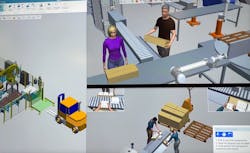The capabilities of simulation software have developed rapidly over the past few years and underpin some of the more exciting possibilities in automation, including the industrial metaverse. But there’s no need to dwell on the potential applications of simulations and digital twins when there’s plenty for manufacturers to sink their teeth into today when it comes to applying available technologies.
As Siemens highlighted in its booth at Pack Expo, OEMs, production line builders and manufacturers can now use digital twins to manage numerous applications—from equipment design to designing robotic cells or complete production lines.
Colm Gavin, portfolio development manager at Siemens Digital Industries Software, explained that the digital twin features of Siemens Plant Simulation are not just smart components that have the geometrical space of a conveyor or tank on the plant floor. They also contain “the metadata of what's associated with that part, such as its speed or fill rates.”
These key data points are contained in the digital twins of these components and stored in the software’s library for building up a library of components to lay out a production facility and store them for reuse in other facilities or as the principal facility explores changes.
Beyond mechanical and operational metadata, the digital twin software also considers human ergonomics to help determine when an operation should transition from manual labor to robots. Gavin said the software helps determine if you are “conforming to local standards related to safety risks or factors such as back fatigue.”
In the video below, Colm Gavin of Siemens Digital Industries Software explains the capabilities of the Tecnomatix Plant Simulation software.
Siemens goal for its Plant Simulation software is to allow users to implement plant-wide optimization more effectively. “We want to verify if the facility is giving us the output we really want,” said Gavin. The software helps with this via its statistical analysis of bottlenecks, throughput, machine efficiency and labor efficiency.
It helps users determine if they’re producing what they need, when they need it and if they need extra equipment or extra buffer lines. “We can simulate all of this all ahead of time before anything is built—from machine design to line design,” said Gavin.
Once the line design is completed, the simulation software can then be used to simulate what-if scenarios for continuous line or plant optimization.

